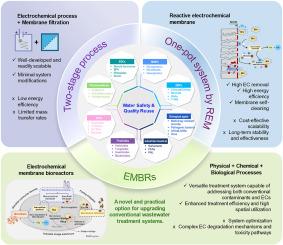Recent advances in membrane and electrochemical hybrid technologies for emerging contaminants removal
IF 8.7
Q1 Environmental Science
引用次数: 0
Abstract
Emerging contaminants (ECs) pose significant risks to environmental and human health, necessitating advanced treatment technologies. Integrating electrochemical processes with membrane filtration has emerged as a promising solution for preventing the leakage of various ECs in water and wastewater treatment. This review critically evaluates recent applications of hybrid membrane and electrochemical technologies for EC removal, systematically examining various configurations such as two-stage processes, one-pot systems with reactive electrochemical membranes, and electrochemical membrane bioreactors (EMBRs). The review highlights their working mechanisms, performance, and energy efficiencies in removing ECs. It analyzes the potentials and challenges of each hybrid configuration: two-stage processes, while easily integrated into existing systems, face energy efficiency limitations; one-pot systems offer promise in enhancing energy efficiency and membrane self-cleaning but need further research for scalability and long-term effectiveness; and EMBRs, which integrate physical, chemical, and biological processes, require additional studies to optimize performance and address complex interactions. Future research should also focus on understanding the degradation mechanisms and toxicity pathways of ECs, as well as on developing cost-effective and scalable membrane-electrochemical hybrid technologies for newly identified contaminants.

新兴污染物去除的膜和电化学混合技术的最新进展
新出现的污染物对环境和人类健康构成重大风险,需要先进的处理技术。将电化学过程与膜过滤相结合已成为防止水和废水处理中各种ECs泄漏的一种有前途的解决方案。本文对混合膜和电化学技术在去除EC方面的最新应用进行了批判性评估,系统地研究了各种配置,如两阶段工艺、带有反应性电化学膜的一锅系统和电化学膜生物反应器(EMBRs)。该综述强调了它们在去除ec方面的工作机制、性能和能效。它分析了每种混合配置的潜力和挑战:两阶段过程虽然很容易集成到现有系统中,但面临能效限制;一锅式系统有望提高能源效率和膜自清洁,但需要进一步研究可扩展性和长期有效性;而集成了物理、化学和生物过程的EMBRs需要进一步的研究来优化性能并解决复杂的相互作用。未来的研究还应侧重于了解ec的降解机制和毒性途径,以及开发具有成本效益和可扩展的膜-电化学混合技术来处理新发现的污染物。
本文章由计算机程序翻译,如有差异,请以英文原文为准。
求助全文
约1分钟内获得全文
求助全文
来源期刊

Water Cycle
Engineering-Engineering (miscellaneous)
CiteScore
9.20
自引率
0.00%
发文量
20
审稿时长
45 days
 求助内容:
求助内容: 应助结果提醒方式:
应助结果提醒方式:


